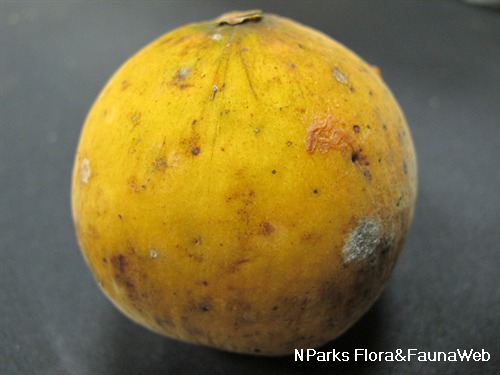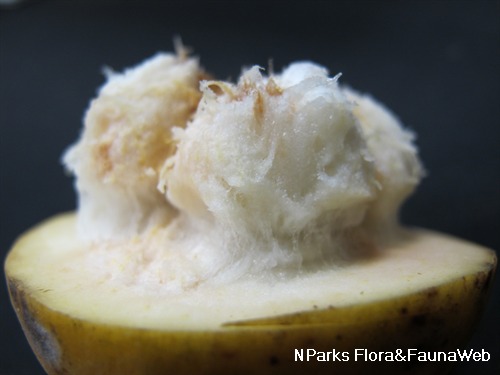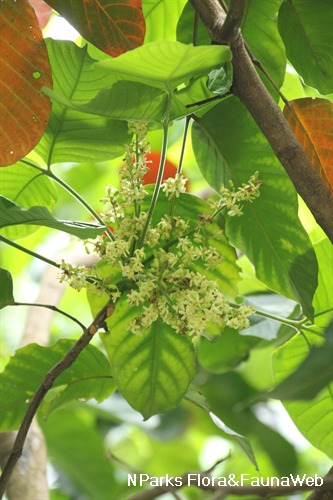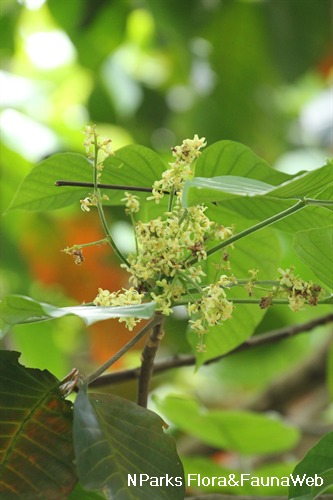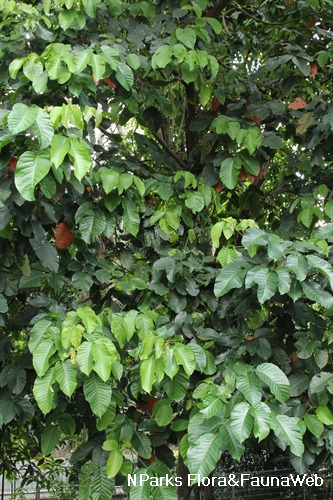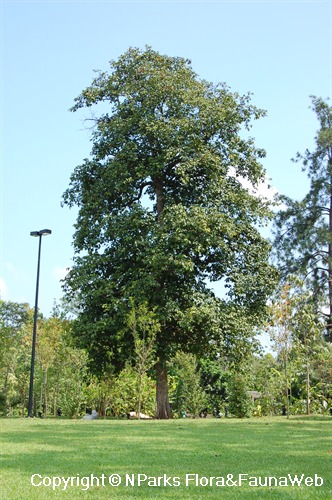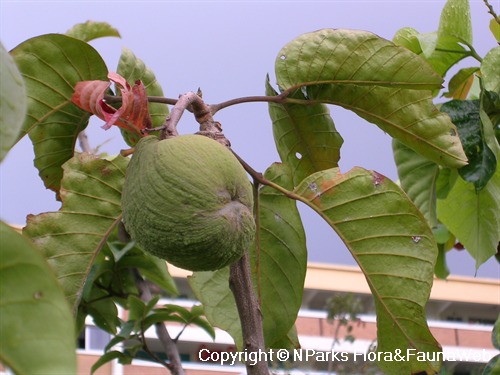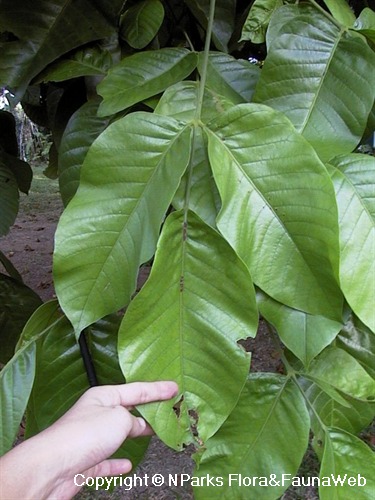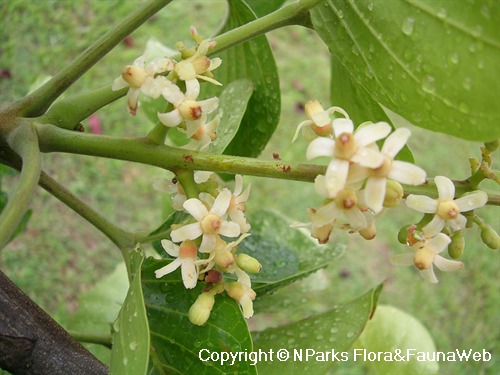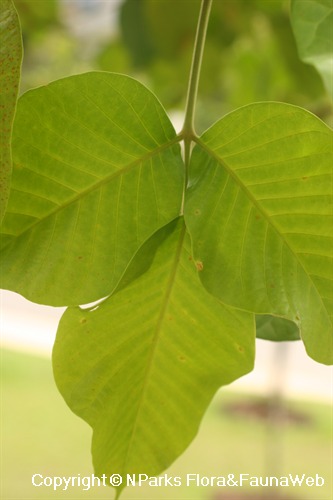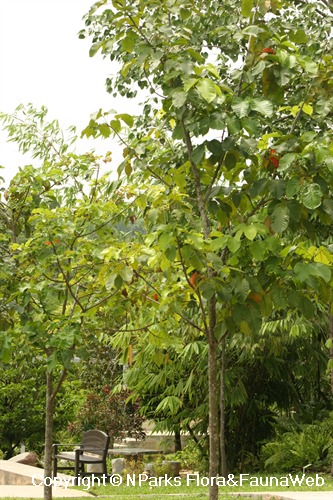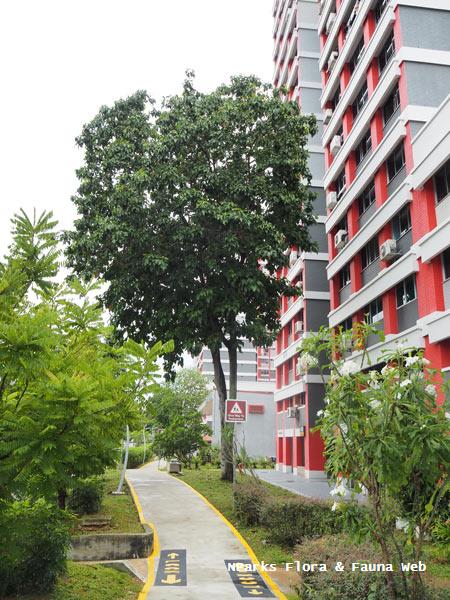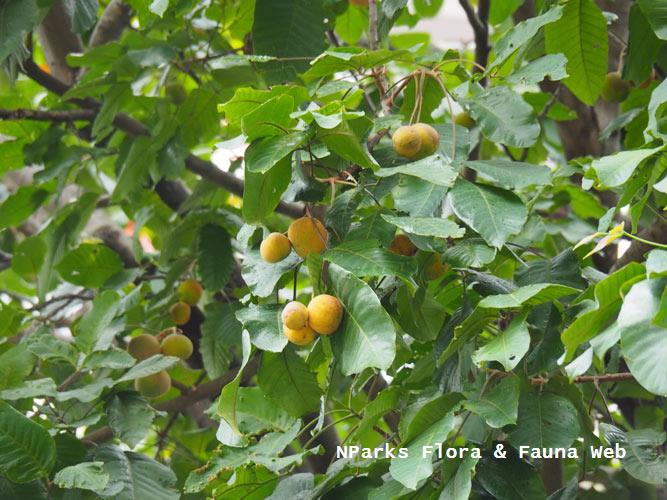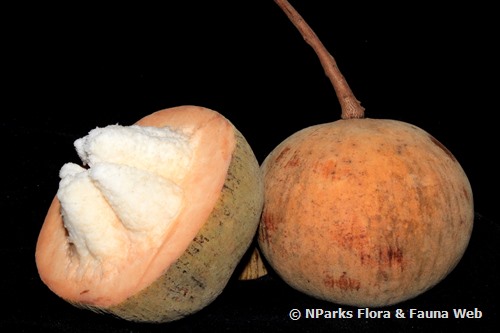
Back
Sandoricum koetjape (Burm.f.) Merr.
| Family Name: | Meliaceae |
| Synonyms: | Melia koetjape Burm.f., Sandoricum indicum Cav., Sandoricum maingayi Hiern., Sandoricum nervosum Blume, Sandoricum radiatum King, Sandoricum vidalii Merr. |
| Common Name: | Sentul, Santol, Sentol, Kechapi, Kecapi, Kelampu, Ketjape, Ketuat, Lolly Fruit, Ranggu, Red Santol, Yellow Sentol, 三都儿, 三道栋 |
Name
Classifications and Characteristics
| Plant Division | Angiosperms (Flowering Seed Plants) (Dicotyledon) |
|---|---|
| Plant Growth Form | Tree |
| Lifespan (in Singapore) | Perennial |
| Mode of Nutrition | Autotrophic |
| Plant Shape | Irregular |
| Maximum Height | 50 m |
| Tree or Palm – Trunk Diameter | 0 m to 1 m |
Biogeography
| Native Distribution | From Sumatra, through Peninsular Malaysia and Borneo, to New Guinea |
|---|---|
| Native Habitat | Terrestrial (Primary Rainforest, Secondary Rainforest, Coastal Forest) |
| Preferred Climate Zone | Tropical |
| Local Conservation Status | Native to Singapore (Vulnerable (VU)) |
Description and Ethnobotany
| Growth Form | It is a large, evergreen tree, up to 50 m tall, with high buttressed roots. |
|---|---|
| Trunk | Its trunk is straight with low branches and high buttress roots (up to 3 m tall in mature specimens). Grey bark is usually smooth, but sometimes flaky or fissured. Young branches are thickly covered in short, brown hairs. |
| Foliage | It has alternate, long-stalked compound leaves are spirally arranged. Each leaf has 3 leaflets that are elliptic to oblong-ovate with pointed tips and rounded bases, and entire or wavy leaf margins. The apical leaflets are 6–26 by 3–16 cm, and the lateral leaflets are smaller, 4–20 by 2–15 cm Leaflets have sunken veins that create an uneven leaf texture. Leaflets are glossy green above, pale green below, and the undersides can be densely covered by short, soft brown hairs. Dark green leaves become bright red before dying. |
| Flowers | It produces bisexual flowers that are pinkish yellow, yellowish green, or white-yellow, fragrant, about 1 by 1.3 cm, possessing five free petals. The flowers are loosely arranged in axillary branched infloresences known as panicles (15 to 30 cm in length). Flowering typically occurs once a year. |
| Fruit | It produces fleshy fruits that are round or flattened ball-shaped, yellow or brownish, and 5-8 cm across. The thin or thick rind has a wrinkled, softly hairy surface and contains a milky juice. The white, juicy pulp surrounding the seeds (known as arils) may be sour to sweet. The fruit has 3 - 5 brown, ovate to ellipsoid seeds, 2–3.5 by 1.2–2.1 by 0.9–1.6 cm, which are usually tightly associated to the pulp. |
| Habitat | It can be found in primary and secondary forests, up to 1,200 m altitude. |
| Associated Fauna | Its flowers are pollinated by insects. The fruits are eaten by frugivorous mammals. |
| Cultivation | This species grows quickly. It should be planted in fertile, well-draining soil that is acidic to neutral (pH = 6 - 7.5). It can be propagated by seed, budding, grafting and marcotting. Seeds must be sown immediately, as they quickly lose viability. About 90-95% of the seeds will germinate, usually within 16-31 days. |
| Etymology | Latin Sandoricum, the Moluccan name of this species, sandori; Latin koetjape, one of the Indonesian name of this species, ketjapi |
| Ethnobotanical Uses | Edible Plant Parts : Edible Fruits Food (Fruit or Vegetable): The whitish pulp of the fruit is consumed raw or made into marmalade, candy and fermented beverages. Medicinal: The various parts are used in folk medicine, such as leaf decoctions for diarrhea and fever, bark poultice for ringworm and roots mixed with vinegar and water for diarrhea and dysentery. The stem contains 2 anti-inflammatory compounds, 3-oxo-12-oleanen-29-oic acid and katonic acid (Rasadah et al 2004). Timber & Products: It is also harvested for timber, which is red, fairly hard, and is used to make boats, carts, fences, houses and furniture. Cultural / Religious: Heritage Tree : There are one individual of Sandoricum koetjape listed as Heritage Trees in Singapore. To find out more about these trees, please visit the Heritage Tree Register. Others: The bark can be used to tan fishing nets. In Sarawak, the fruit is used as fish bait. The aromatic wood contains compounds that are added to perfumes. |
Landscaping Features
| Landscaping | It is suitable as a roadside tree, as it is able to grow relatively fast and provide shades, and is quite firm. Although the fruits create interest, they drop at maturity, creating a litter problem. The roots stabilize soil, preventing erosion. |
|---|---|
| Desirable Plant Features | Ornamental Foliage |
| Landscape Uses | Suitable for Roadsides, General, Parks & Gardens, Small Gardens, Shade Providing Tree / Palm |
| Thematic Landscaping | Economic Garden |
Fauna, Pollination and Dispersal
| Pollination Method(s) | Biotic (Fauna) |
|---|---|
| Seed or Spore Dispersal | Biotic (Fauna) |
Plant Care and Propagation
| Light Preference | Full Sun, Semi-Shade |
|---|---|
| Water Preference | Moderate Water |
| Plant Growth Rate | Fast |
| Rootzone Tolerance | Fertile Loamy Soils, Well-Drained Soils, Drought Tolerant |
| Propagation Method | Seed, Grafting, Marcotting |
| Propagation Method Remarks | Budding |
Foliar
| Foliage Retention | Evergreen |
|---|---|
| Mature Foliage Colour(s) | Green, Red |
| Mature Foliage Texture(s) | Glossy / Shiny, Raised / Sunken Veins |
| Foliar Type | Compound (Trifoliate) |
| Foliar Arrangement Along Stem | Spiral, Alternate |
| Foliar Attachment to Stem | Petiolate |
| Foliar Shape(s) | Non-Palm Foliage (Elliptical, Oblong) |
| Foliar Venation | Pinnate / Net |
| Foliar Margin | Entire, Entire - Wavy / Undulate |
| Foliar Apex - Tip | Acute |
| Foliar Base | Rounded / Obtuse |
| Typical Foliar Area | Macrophyll ( 182.25cm2 - 1640.25 cm2 ) |
| Leaf Area Index (LAI) for Green Plot Ratio | 3.0 (Tree - Intermediate Canopy) |
Non - Foliar and Storage
| Trunk Type (Non Palm) | Woody |
|---|---|
| Bark Colour(s) | Grey |
| Mature Bark Texture | Fissured, Peeling / Flaking / Papery, Smooth |
| Root Type | Underground (Tap Root) |
Floral (Angiosperm)
| Flower & Plant Sexuality | Bisexual Flowers |
| Flower Colour(s) | White, Cream / Off-White, Yellow / Golden |
|---|---|
| Flower Grouping | Cluster / Inflorescence |
| Flower Location | Axillary |
| Flower Symmetry | Radial |
| Individual Flower Shape | Stellate / Star-shaped |
| Flower Size - Remarks | 1 cm wide |
| Inflorescence Type | Panicle |
| Flowering Period | Once Yearly |
| Flowering Habit | Polycarpic |
Fruit, Seed and Spore
| Mature Fruit Colour(s) | Yellow / Golden |
|---|---|
| Mature Fruit Texture(s) | Velvety / Furry / Tomentose |
| Fruit Classification | Simple Fruit |
| Fruit Type |
Image Repository
Others
| Master ID | 1816 |
|---|---|
| Species ID | 3109 |
| Flora Disclaimer | The information in this website has been compiled from reliable sources, such as reference works on medicinal plants. It is not a substitute for medical advice or treatment and NParks does not purport to provide any medical advice. Readers should always consult his/her physician before using or consuming a plant for medicinal purposes. |


